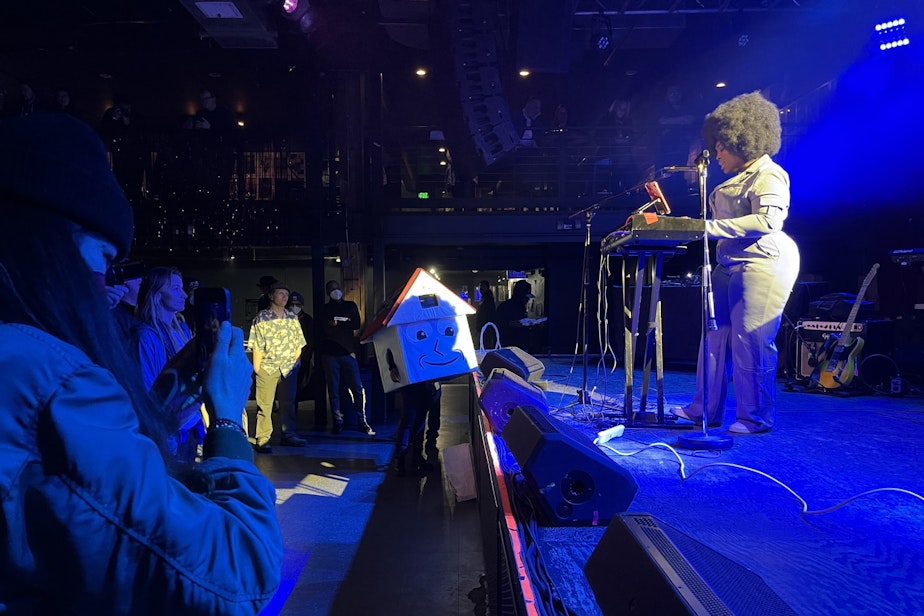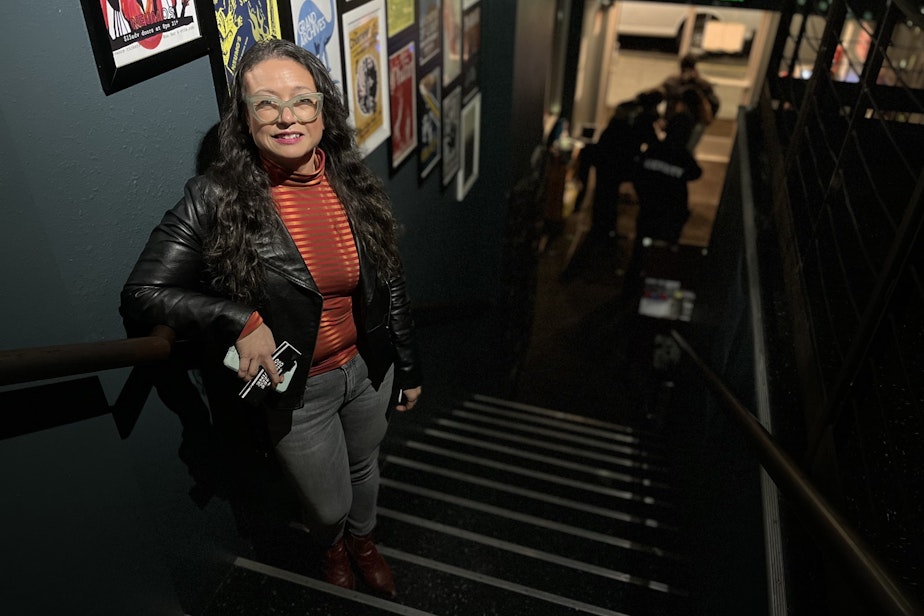Social housing in Seattle? Arguments for and against it

There’s only one thing on the Seattle ballot this month: social housing.
Initiative 135 would create a publicly owned developer that builds and preserves affordable housing. The apartments would serve a broader range of incomes than most affordable housing does today.
We looked at the arguments for and against it.
O
n Sunday night at Neumo’s, Shaina Shepherd stands alone on stage at the keyboard, pink and blue lights behind her. She’s here to sing, but also to talk about Seattle’s social housing initiative.
During a quiet moment she tells the crowd about a time in 2017 when she lived on the streets of Capitol Hill, following the loss of a job. She hung out in clubs like Neumo’s and Vermillion.
“I was very dirty, and I was excited to use the bathrooms over there. And it was one of those shows where everybody was having just an incredible party. And I danced, and I sang, and I was treated like a person, until 2:15 a.m.”
Shepherd told this story to illustrate her connection to a neighborhood that sustains her, both as a musician and member of a supportive, creative community. It explains why she needs to live there.
Later, she eventually found housing on Capitol Hill near Miller Park. But she says it’s more expensive than she can afford, and she’s been on the waitlist for affordable housing for three and a half years.
Sponsored
The argument for social housing
The people behind I-135 say we need a new approach: one that creates more housing for a broad range of income levels.
Earning an average income isn’t enough to afford Seattle rents anymore.
“We need a good, viable solution for those that fall in the cracks,” says Dawn Dailey, an official with the 43rd District Democrats who has also struggled with being unhoused in the past. “There are a lot of people that you would look at and deem successful – that have great flourishing jobs, but we simply cannot compete with the young tech workers.”
Sponsored

Dailey says one thing that makes social housing different is that it would create projects that include affordable apartments for people earning medium incomes. That’s up to $120,000 for a household of four. And it would use rents from those relatively higher earners to help subsidize the lower income renters.
She says this would set up the whole system to be self-sufficient in 18 months. After it's up and running, the organization would start looking for new sources of funding to help it actually start buying and building properties.
“I’m not gonna say it is the solution, but it is a solution that we have that is an immediate deliverable within a year and a half’s time,” Dailey said.
How it would work
Technically, the public developer created by the initiative would be a public development authority, like the one that governs the Pike Place Market's management and development. In the case of the market, the public development authority brings public ownership and public values to a development process that might otherwise value profit over the public good.
While public development authorities are difficult to create, politicians have floated the idea in recent years of using them to approach difficult problems.
Back when she was a state representative from Magnolia, Gael Tarleton toyed with the idea of creating a public development authority to govern planning and development of a new neighborhood in Seattle's Interbay neighborhood after the National Guard abandons its large property there.
Here are a few more facts, based on the initiative language, about how the Seattle social housing developer (aka "Public Developer") would operate.
Sponsored
- The Public Developer could build — or purchase existing — housing, which it would then own and keep permanently affordable. The building can't be sold off later to a private entity. Organizers have told KUOW it's likely many of the first buildings will be purchases, rather than new developments.
- The building must include a mix of household income ranges, from very low income to moderate income. No one may be asked to pay more than 30% of their income in rent.
- Residents must have opportunities to help make decisions about how to run their building.
- The public developer will use a lottery system, rather than rental references, co-signers, and background checks to decide who gets a rental unit.
- The public developer will be overseen by a board that includes some technical experts and some people who have limited incomes or have faced eviction.
- Tenants won't be displaced if the public developer takes over a building. But over time, it'll bend towards achieving the proper mix of residents as tenants turnover.
- New and purchased developments have to meet passive house standards, which means they'll be extremely energy efficient but also more expensive to build or retrofit up front.
- New developments should include daycare, communal kitchens, affordable co-op working spaces.
The argument against social housing
Opponents of Social Housing say the plan spends money in the wrong place.

Alice Woldt helped write the statement against I-135. She’s a longtime housing advocate.
Sponsored
She met me in front of an apartment building.
“We’re standing in front of the Toft Terrace, it is a Plymouth Housing building,” she said.
The project is just south of Ballard High School, and it serves people who used to live on the streets.
Woldt says this is the population that needs housing the most desperately.
Does she object to the fact that social housing would also serve people making more than the average (median) income?
"It isn’t that I don’t like it. I think a mixture of people together is probably a good idea. What I do object to is, given the crisis that we face in this community, with the number of homeless people," is that social housing is a misallocation of limited resources, she says. Those resources include money, but also land.

She says if we're willing to spend more money, or ask governments to offer more surplus land for affordable housing, those resources would be better utilized by organizations like Plymouth Housing, which has built up a lot of experience over the last 40 years.
She explained how she came to have this faith. Back in 1980, her pastor led downtown's Plymouth Congregational Church on a mission to turn derelict buildings into housing for people who were sleeping on the church doorstep. Like other congregants, she donated furniture to the cause.
Since then, she has gone on to watch Plymouth Housing and others (including the Downtown Emergency Service Center, where she says she was a founding board member) become part of the collection of housing providers that understand the complexities and expenses involved in building affordable housing.
“They have knowledge about what it takes to build these, what the financing mechanisms are, and I think can do it faster.”
Toft Terrace benefited, she says, from recent attempts by the city to streamline approval for affordable housing projects.
Proponents of I-135 reject the argument that social housing would take funds away from affordable housing developers. They say it’s not about competing for limited resources, it’s about growing the size of the pie, so that more people can have a slice.
O
ne thing both sides agree on though, is that Seattle needs to change how it does things. What they disagree on is whether a new model will complement or distract us from current efforts.
Fans of I-135 say their model has been successful in cities like Vienna, where a large percentage of the population lives in social housing and people pay no more than 20% of their income to live there.
On the other hand, people against this initiative say we already have a system that works — we just have to put enough money into it. And they say that’s something we’ve never done.
Ballots for the special election are due on Feb. 14.


